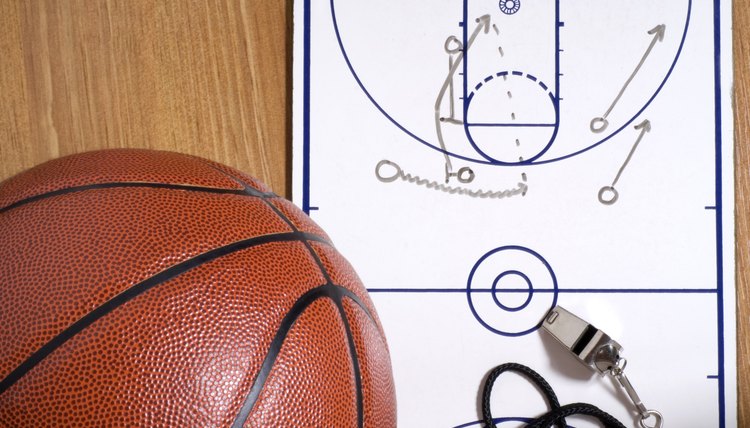Rules, Regulations and Mechanics in Basketball

Basketball has come a long way since its creation in 1891 by Dr. James Naismith in Springfield, Massachusetts. It has become a global phenomenon with millions of individuals playing the game at the professional, collegiate, high school and recreational levels. Before trying your hand at basketball, take the time to learn about its rules, regulations and mechanics.
Teams and Positions
Five players are assigned to opposing teams, with each team made up of a point guard, shooting guard, small forward, power forward and center. Point guards are generally the smallest and quickest players on the floor and are the primary ball handlers and facilitators in the offense. Shooting guards and small forwards are average-sized players and are commonly referred to as "wings." They do a bit of everything, such as scoring from the inside and outside, distributing, ball handling and rebounding. Power forwards and centers are the "big men" on the court who primarily score from the interior and are responsible for grabbing the majority of the rebounds.
Regulation Length and Shot Clock
In the National Basketball Association (NBA), regulation lasts for four 12-minute quarters. In high school basketball, each quarter lasts for eight minutes, and in college basketball, teams play for two 20-minute halves. If the score is tied at the end of regulation, continuous overtime periods are played until a winner can be determined. NBA and college basketball use five-minute overtime periods, while overtime lasts for four minutes in high school basketball. Lastly, there is no shot clock in high school. In the NBA, teams are given 24 seconds to shoot, and in college basketball, they are given 35 seconds.
Court Dimensions
Overall, the court is 94 feet long and 50 feet wide. The NBA three-point line is 23 feet, 9 inches away at the top of the key and 22 feet away at the corners. In men's college basketball, this line moves in to 20 feet, 9 inches away all the way around. In women's college basketball and in high school basketball, this line is 19 feet, 9 inches away. And at all levels, the free-throw line is 15 feet away from the basket.
Fouls
Personal fouls occur when defenders make illegal contact with their opponents. If an opponent is in the act of shooting, free-throws are awarded. In high school and college, five personal fouls warrants an ejection, while professionals may commit six fouls before being disqualified. Technical fouls generally occur when a player behaves with unsportsmanlike conduct. In the NBA and college, the opposing team is awarded one free throw and possession of the ball. If a player draws two technical fouls, they will be ejected. Finally, two types of flagrant fouls exist. Type 1 is for either exceptional or excessive contact. Type 2 is when the contact is both exceptional and excessive. In both cases, the opposition receives two free throws and possession afterward. Disqualification occurs after two type-1 fouls or one type-2 foul in the NBA .
Scoring
Each basket made in front of the three-point line is awarded two points. Baskets from behind this line are awarded three points. You also receive one point for each made free-throw -- taken without interference from the free-throw line. If you are fouled in the act of shooting from the two-point range, you will receive two free-throws. If you were fouled when shooting beyond the three-point line, you will receive three free-throws. If you make the basket while being fouled simultaneously, that basket will count and you will receive one free-throw.
Dribbling Mechanics
The proper mechanics for dribbling a basketball require that you keep the ball low and close to your body in order to make it as difficult as possible for the defender to steal the ball. Spread your fingers out wide and attempt to dribble with just your fingertips for greater control. Once you pick up your dribble, you are allowed two steps and are not allowed to dribble again. Taking more than two steps will result in a traveling violation, while dribbling again will result in a double dribble. The consequence of each offense is that the opposing team will be awarded possession.
Shooting Mechanics
To properly shoot a basketball, have your feet shoulder-width apart and pointing directly toward the basket. Your shoulders should be squared to the basket as well. Your lead foot should be just in front of the other and in line with the basket. The elbow of your lead hand should be in line with this foot as you raise the ball to shoot. This will help assure that the ball will follow the direction of your foot and elbow, which should both be directly in line with the basket. Place your weak hand on the side of the ball during your shooting motion for greater stability prior to your release.
References
Writer Bio
Michael Tonkonogy is a certified personal trainer from the International Sports Science Association who writes on health and fitness. He earned a Bachelor of Arts in psychology from the University of California, Berkeley. He has previous experience as a sportswriter, writing primarily about the Pac-12 conference during his senior year of college.
